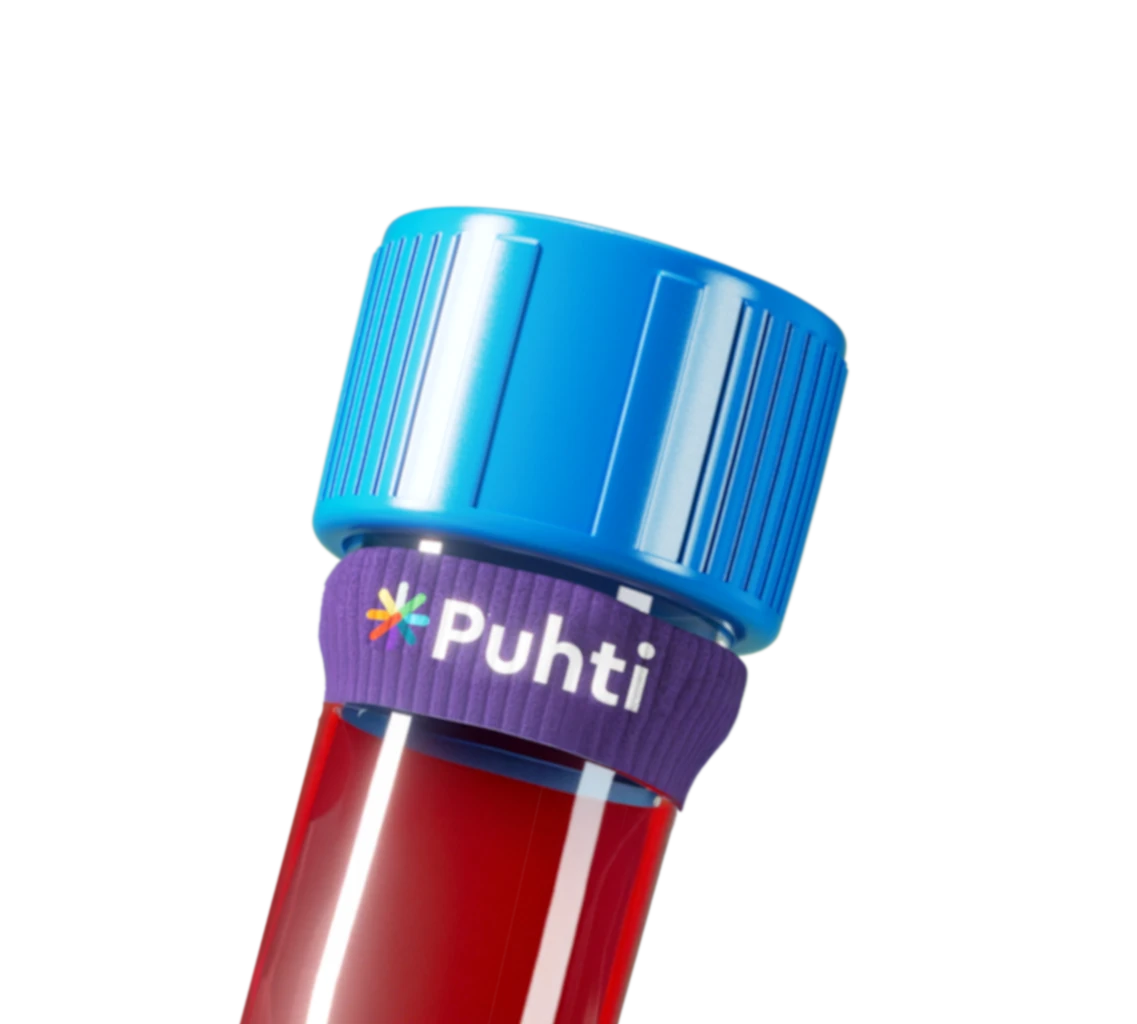
Hemoglobin (B-Hb) – Measurement and reference values
When suspecting anemia, it is important to test the hemoglobin. Symptoms of iron deficiency anemia include paleness and fatigue.

Hemoglobin (B-Hb) – Measurement and reference values
When suspecting anemia, it is important to test the hemoglobin. Symptoms of iron deficiency anemia include paleness and fatigue.
Hemoglobin (B-Hb)
- Hemoglobin is an iron-rich, oxygen-binding protein that transports oxygen from the lungs to tissues and carbon dioxide back to the lungs.
- Hemoglobin is always examined in connection with a blood count.
- In anemia, the level of hemoglobin in the blood is lower than normal.
- Anemia usually causes fatigue, impaired physical performance, dizziness, and shortness of breath.
What is hemoglobin (B-Hb)?
Hemoglobin is an iron-rich oxygen-binding protein that transports oxygen from the lungs to tissues and carbon dioxide back to the lungs. Hemoglobin is what gives blood its red color. Its primary function is to transport oxygen throughout the body, for instance, to the muscles and the heart.
Hemoglobin is examined as part of a blood count test used to diagnose various symptoms.
When suspecting anemia, it is important to test the hemoglobin. Iron deficiency anemia is the most common form of anemia. Symptoms of iron deficiency anemia include paleness and fatigue. Other symptoms of iron deficiency anemia include decreased physical performance and impaired general health, palpitations, shortness of breath, dizziness, and weakness.
If iron deficiency is suspected, we also recommend testing the ferritin levels (the primary indicator of iron deficiency) and inflammation (CRP), which in turn affects ferritin levels.
Reference values for hemoglobin
Hemoglobin reference values are different for men and women. In Finland, hemoglobin levels are expressed in grammes per litre (g/l).
Reference values for women
For women, hemoglobin reference values are 117–155 g/l. On average, women have lower hemoglobin levels than men. Values vary based on age and other factors. For women of childbearing age, for example, menstruation may affect hemoglobin. Hemoglobin levels are unique to everyone.
According to the WHO, the lower limit for hemoglobin in women is 120 g/l.
Reference values may vary depending on the laboratory and the test analysis method.
Reference values for men
For men, hemoglobin reference values are 134–167 g/l. I After puberty, in general, men have higher hemoglobin levels than women.
According to the WHO, the lower limit for hemoglobin in men is 130 g/l.
Reference values may vary depending on the laboratory and the test analysis method.
Low hemoglobin level
Low hemoglobin is associated with anemia. In anemia, the level of hemoglobin in the blood is lower than normal. Anemia is always an anomalous finding. The cause of low hemoglobin should always be investigated to ensure right treatment. Iron-deficiency anemia is the most common cause but there could also be another underlying illness.
Hemoglobin and anemia
Hemoglobin values B-Hb (g/L) and the classification of the severity of anemia (according to WHO) are shown in the table below:
| Mild | Significant | Severe | |
| Women 15–65 years | 110–119 | 80–110 | <80 |
| Pregnant women | 100–109 | 70–99 | <70 |
| Men 15–65 years | 110–129 | 80–110 | <80 |
Symptoms of low hemoglobin
In anemia, the level of hemoglobin in the blood is lower than normal. Anemia usually causes fatigue, impaired physical performance, dizziness, and shortness of breath.
Symptoms of mild anemia:
- fatigue
- impaired physical performance (for example, not being able to exercise like before)
Symptoms of severe anemia:
- profound fatigue
- feelings of dizziness
- shortness of breath
Anemia in elderly people
Anemia is more common in elderly people, mainly because diseases causing anemia become more common with age and it is common for elderly people to not get all the necessary nutrients from their diet.
The diet of elderly people can often be inadequate. Thus iron deficiency anemia may occur in the elderly, resulting in low hemoglobin. In addition to iron, elderly people should also pay attention to adequate intake of protein, vitamin B12, and folate, for example.
How to raise the hemoglobin level and prevent anemia?
The first step is to find out the cause of the anemia.
Iron deficiency can be prevented with a diet containing sufficient amount of iron. Vegetarians and vegans can also get enough iron through their diet, although the absorption of plant-derived iron is lower than that of animal-derived iron. If a person’s iron stores are depleted, this results in iron deficiency anemia. Underlying causes often include more than just a diet low in iron.
The primary source of iron is food but if the diet is not sufficient to heal the iron deficiency, iron can also be taken as a dietary supplement.
In iron deficiency anemia, iron supplements are always needed as a treatment. However, even if taking supplements, the diet should also be adjusted to include more iron. In addition to iron-rich foods, we recommend paying attention to factors that affect the absorption of iron. In some cases, intravenous iron infusion is used to treat iron deficiency anemia.
In terms of diet, in addition to an adequate intake of iron, it is also advisable to ensure an adequate intake of vitamin B12 and folate. Vegans and the elderly, in particular, can suffer from vitamin B12 deficiency. Inadequate intake of folate in diet is common in Finns.
High hemoglobin level
Hemoglobin level may also be too high.
High hemoglobin levels may be due to:
- smoking
- dehydration
- polycythaemia (a condition in which there is an increase in the number of red blood cells per unit volume)
- chronic oxygen deprivation (e.g. due to high altitude)
- the EPO hormone
Hemoglobin levels may exceed the reference values if the body suffers from an extended period of reduced supply of oxygen. Therefore, an increase in hemoglobin is a reaction to the insufficient oxygen intake. For this reason, people living in mountainous regions have, on the average, higher hemoglobin levels than people living in lower altitudes.
In chronic lung diseases, the transmission of oxygen to the blood is disrupted and the hemoglobin level may increase.
A small share of population have naturally high hemoglobin levels.
Hemoglobin level for athletes
Iron is important for athletes, and special attention should be paid to its intake. Athletes and people who exercise often have an increased need for iron intake.
Athletes can benefit from measuring their hemoglobin levels, especially if they have experienced changes in their well-being or performance. Iron levels can be measured at the same time. Hemoglobin carries oxygen to the muscles. However, hemoglobin alone does not reveal the full picture of an athlete’s iron levels. Hemoglobin does not decrease until iron deficiency has continued for a long time.
Hemoglobin falling within the reference values does not automatically mean that a person’s iron stores are sufficient. The status of the iron stores is primarily determined by examining the ferritin value.
In other words, the hemoglobin results can be normal even if the iron stores are deficient. This is primarily remedied with diet.




